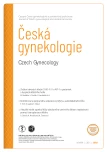Myomas in uterine rudiments in a patient with Mayer-Rokitansky-Küster-Hauser syndrome
Authors:
Hricko M. 1; Chmel R. jr. 1,2; Pastor Z. 1
Authors‘ workplace:
Gynekologicko-porodniká klinika, 2. LF UK a FN Motol, Praha 2 LF UK v Plzni
1
Published in:
Ceska Gynekol 2021; 86(1): 36-39
Category:
Case Report
doi:
https://doi.org/10.48095/cccg202136
Overview
Objective: To describe the case of a patient with Mayer-Rokitansky-Küster-Hauser (MRKH) syndrome and a history of chronic pelvic pain due to myomas in the rudimentary uterine horns. The article highlights a rare origin of gynaecological pain.
Case report: We present the case of 61-year-old woman with MRKH syndrome who has suffered from chronic abdominal pain for more than one year before surgery. Using magnetic resonance imaging and ultrasonography, a suspicion on the tumours of uterine myoma character in the rudimentary horns was suggested. It was confirmed by laparoscopy. Myomas were removed in the endobag and histopathologically confirmed.
Conclusion: MRKH syndrome is a very rare disease. Approximately ten women are annually born with this congenital anomaly in the Czech Republic. While myoma incidence is extremely rare in this group of women, it must be taken into account in differential diagnosis and solved surgically in time.
Keywords:
Mayer-Rokitansky-Küster-Hauser syndrome – rudimentary uterine horn – myoma uteri
Sources
1. Aittomäki K, Eroila H, Kajanoja P. A population-based study of the incidence of Müllerian aplasia in Finland. Fertil Steril 2001; 76 (3): 624–625. doi: 10.1016/s0015-0282 (01) 01 963-x.
2. Valappil S, Chetan U, Wood N et al. Mayer-Rokitansky-Küster-Hauser syndrome: diagnosis and management. Obstet Gynaecol 2012; 14 (2): 93–98. doi: 10.1111/j.1744-4667.2012.00097.x.
3. Hentrich T, Koch A, Weber N et al. The endometrial transcription landscape of MRKH syndrome. Front Cell Dev Biol 2020; 8: 572281. doi: 10.3389/fcell.2020.572281.
4. McQuillan SK, Grover SR. Systematic review of sexual function and satisfaction following the management of vaginal agenesis. Int Urogynecol J 2014; 25 (10): 1313–1320. doi: 10.1007/ s00192-013-2316-3.
5. Chmel R jr, Pastor Z, Mužík M et al. Syndrom Mayer-Rokitansky-Küster-Hauser – ageneze dělohy a pochvy: aktuální znalosti a terapeutické možnosti. Ceska Gynekol 2019; 84 (5): 376–383.
6. Sultan C, Biason-Lauber A, Philibert P. Mayer-Rokitansky-Kuster-Hauser syndrome: recent clinical and genetic findings. Gynecol Endocrinol 2009; 25 (1): 8–11. doi: 10.1080/09513590 802288291.
7. Oppelt PG, Lermann J, Strick R et al. Malformations in a cohort of 284 women with Mayer-Rokitansky-Küster-Hauser syndrome (MRKH). Reprod Biol Endocrinol 2012; 10: 57. doi: 10.1186/1477-7827-10-57.
8. Beecham CT, Skiendzielewski J. Myoma in association with Mayer-Rokitansky-Kuster syndrome. Am J Obstet Gynecol 1977; 129 (3): 346–348. doi: 10.1016/0002-9378 (77) 90801-8.
9. Kundu K, Cohen AW, Goldberg J. Acute torsion of uterine remnant leiomyoma with Mayer-Rokitansky-Küster-Hauser syndrome. Fertil Steril 2014; 102 (2): 607–609. doi: 10.1016/j.fertnstert.2014.04.034.
10. Chmel R, Pastor Z, Matěcha J et al. Uterine transplantaion in the era of successful childbirths from living and deceased donor uteri: current challenges. Biomed Pap Med Fac Univ Palacky Olomouc Czech Repub 2020; 164 (1): 115–120. doi: 10.5507/bp.2019. 020.
11. Pastor Z, Froněk J, Nováčková M et al. Sexual life of women with Mayer-Rokitansky-Küster-Hauser syndrome after laparoscopic Vecchietti vaginoplasty. Sex Med 2017; 5 (2): e106–e113. doi: 10.1016/j.esxm.2016.12.003.
12. Mára M, Frühauf F, Lisá Z. Diferenciální diagnostika děložních myomů. In: Čepický P et al (eds). Kapitoly z diferenciální diagnostiky v gynekologii a porodnictví. Praha: Grada Publishing 2018: 123–128.
13. Stewart EA, Laughlin-Tommaso SK, Catherino WH et al. Uterine fibroids. Nat Rev Dis Primers 2016; 2: 16043. doi: 10.1038/nrdp. 2016.43.
Labels
Paediatric gynaecology Gynaecology and obstetrics Reproduction medicineArticle was published in
Czech Gynaecology

2021 Issue 1
Most read in this issue
- Adverse events of PARP inhibitors
- Combined peripartal pubic symphysis and sacroiliac joint separation
- Aspects of embryo selection and their preparation for the formation of human embryonic stem cells intended for human therapy
- Eating disorders in the ambulance of pediatric and adolescence gynecology
